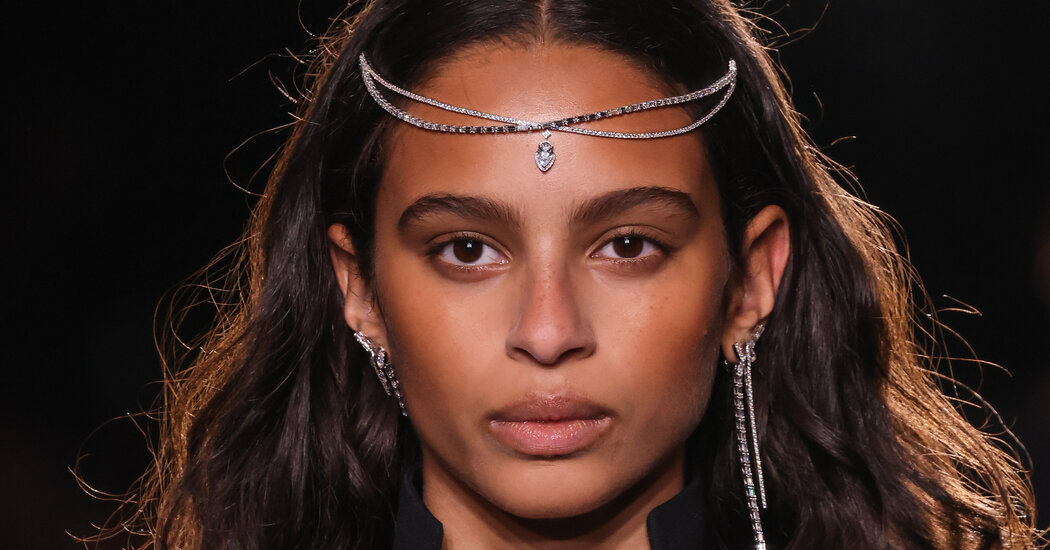
Red carpet fashion events always draw attention — the celebrities! the glamour! the clothes! So it should be no surprise that the hair jewelry seen last fall at the Met Gala (like Rihanna’s bejeweled Stephen Jones skullcap) and the British Fashion Awards (with Poppy Delevingne in star-shaped Swarovski hair pins) has revived interest in the look.
The celebrity stylist Elizabeth Saltzman, who was behind Ms Delevingne’s adornment at the awards, said jewelry in your hair is like “the cherry on top,” a touch that can be magnificent as well as transformative. And, “it’s an easy way to change your look without having to change your clothes,” she said. “It’s makeup for the hair.”
While most hair jewels are inexpensive costume pieces, several luxury labels, from niche brands to the Place Vendôme houses in Paris, have been adding their distinctive offerings to the style.
For example, Beppe D’Elia, who has worked with many major fashion houses in his three-decade career and styled celebrities from Sharon Stone to Bella Hadid, plans to open a flagship store in Milan in March for his hair jewelry brand, introduced in 2020 with the jeweler Nadia Missbach.
Mr. D’Elia said the line was the result of his frustration at seeing clients wearing hundreds of thousands of dollars of couture gowns and jewelry — and a “cheap elastic hair band.”
“I don’t think it’s normal to put in your beautiful hair an elastic that you can buy in the supermarket for 20 cents — and meanwhile you have a 100,000-euro ring,” he said. “It does not make sense.”
His collection, crafted in 18-karat gold and diamonds in Milan, includes gold barrettes (from €230, or $260; €9,900 for designs set with diamonds) and a chunky Pony Pimper, for ponytails, topped with a trio of diamonds (€1,660). A tennis bracelet-like design (€2,200) works for both the hair and wrist, while the dreadlock-inspired Wow Dread clip, with 7.7 carats of diamonds and priced at €18,200, is the collection’s most luxe item.
Place Vendôme houses also have been working the trend, particularly with transformable features, into their high jewelry collections.
Hélène Poulit-Duquesne, Boucheron’s chief executive, said the house’s increasing number of precious hair gems are part of a systematic push to design more multifunctional pieces. “Multi-wear is part of our patrimony,” she said. “As a client, I would prefer to have pieces that can be worn in three different ways, not only one.”
Boucheron’s creative director, Claire Choisne, noted that transformable jewels have always existed. But at Boucheron, “we’ve tried to push the idea — to add a bit of fun,” she said, referring to the Art Deco-themed collection introduced in January 2021 that featured the Ruban Diamants jewel that could be worn as a belt, choker or hair band and the bow-tie style Noeud piece that tripled as a brooch, ring or hair clip.
The maison’s latest collection — which reinterprets a 1928 Boucheron commission from the maharajah of Patiala being unveiled this week — includes the New Sarpech gem (price on application) that recalls lavish, early 20th century turban ornaments. Featuring swirls set with 426 diamonds and complemented by two rose-cut diamonds, the piece was designed to serve as both a brooch and hair piece.
The current popularity of tiaras also is part of the trend, with jewelers again using transformability for a fresh update.
Van Cleef & Arpels’ diamond and sapphire Andromède tiara from its current celestial-themed high jewelry collection included detachable clips, designed to be worn as either hair pins or brooches.
Chaumet is the Place Vendôme house perhaps most synonymous with the tiara, having famously created designs for Empress Josephine and now introducing new styles every year. Some of the creations from the 242-year-old house were highlighted during its 2019 exhibition “Autrement,” which styled old and new Chaumet jewels in contemporary ways: a 1870s feather-style sapphire brooch pinned to the hair; a tiara worn backward, sitting at the base of a topknot bun; and delicate brooches clipped into cornrow braids.
At Paris Fashion Week last fall, hair jewelry got special notice as the Paris jeweler Messika and Kate Moss unveiled their second design collaboration. A host of head jewels appeared on their catwalk, tied around models’ heads and looped through hair, adorning their foreheads or twinkling from hair partings.
Pearls also have a place in hair jewelry, with the Japanese house Tasaki creating nature-themed pieces, like its Coral hair corsage featuring diamond-set coral branches attached to a comb. Or there are the ascending rows of freshwater pearls that punctuate a corsage and head band designs in its Shell collection. And the cascade of different kinds of pearls, gold, and white and gray diamonds that create the Wisteria corsage, a flower that is a symbol of love and longevity.
The ultimate bridal jewel was the starting point for Alighieri’s Captured Magic Veil (1,500 pounds, or $2,035), which the brand’s founder, Rosh Mahtani, created from scraps of chain in her studio. Edgy yet ethereal, the piece also could be worn as a belt.
“It was so exciting to make a versatile piece that felt like couture — the chain is hand linked, piece by piece,” Ms. Mahtani wrote in an email.
Inspired by the hair jewelry worn in Indian and African cultures, Ms. Mahtani created her first hair element in 2015: the Over-Thinker Hair Tie in her signature hammered 24-karat gold plate (£195).
She said she was drawn to hair jewelry’s versatility, the idea that a piece could be worn different ways on the head, with all manner of hair styles.
“Hair jewelry appeals to a minimalist or a maximalist,” she said. “You can layer and weave a tapestry of pieces — or go super chic with one signature hair tie to take any look to the next level.”






